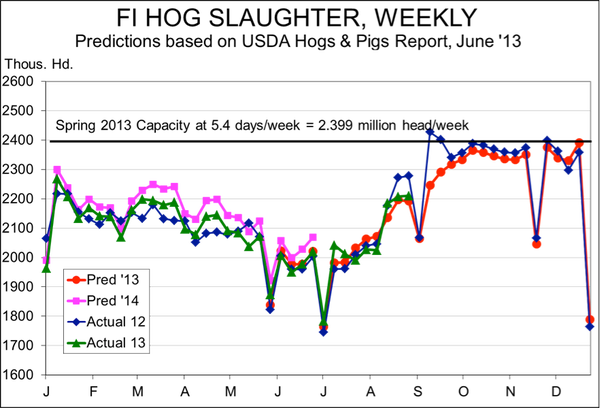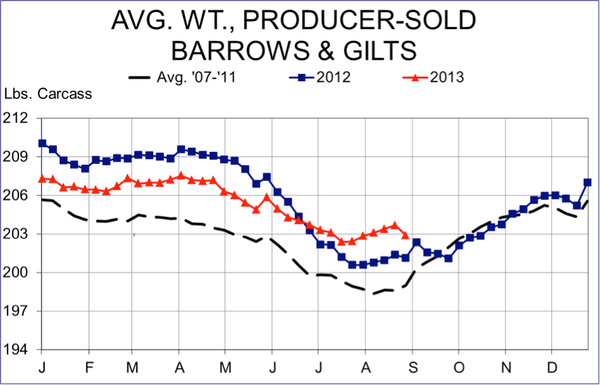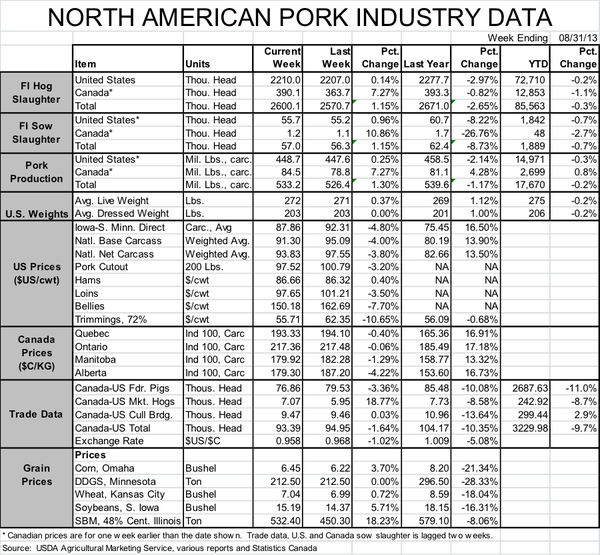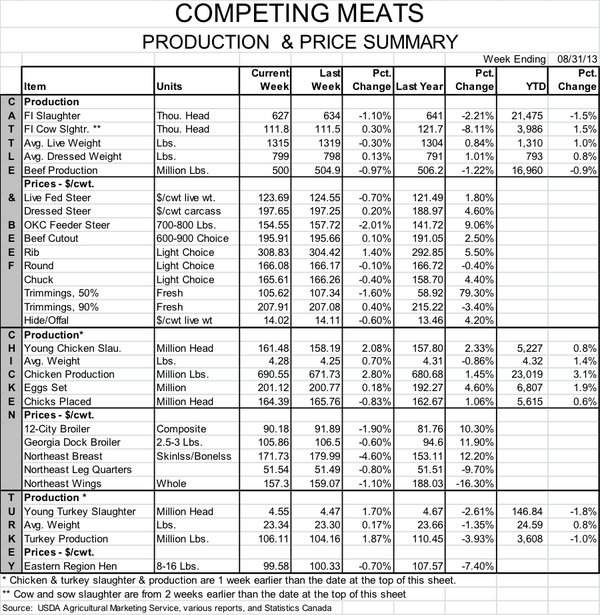What's Impacting Fall Hog Markets?
September 3, 2013

As September dawns, it behooves us to consider the factors that will likely have major impacts on fall hog markets. Those, of course, all fit one way or another into the economist’s pat answer of,“Supply and demand,” but some details will probably be far more illuminating and, hopefully, satisfying.
Hog Numbers
There was an unusual amount of variation in forecasts for fourth quarter slaughter coming out of the June Hogs and Pigs report. Ron Plain and Scott Brown at Mizzou had +1.3% from Q4-2012. Lee Shulz at Iowa State University (ISU) forecast it at +1.1% and Jim Robb and the staff of the Livestock Marketing Information Center in Denver said slaughter would be up 1.6%. Meanwhile, I said DOWN 0.5%. Our forecasts for the current (third) quarter were similarly disparate with the other three up 1.6 to 2.1% and me down 1.5%. Through July and August, FI slaughter this year is almost precisely the same as last year. So far we’re all wrong. That raises your confidence level, doesn’t it?
None of this provides the reader with a lot of guidance, but I do offer the past two weeks as support for my view that slaughter numbers will be tighter in Q4 (See Figure 1). The biggest reason for my lower forecasts was the strange weekly slaughter pattern that extreme heat and extreme feed prices caused last year.

The far more difficult job is to predict what producers, in fact, might do this year. I went back to the historical pattern and, at least until last week, the weather and feed costs had supported that conclusion. Weekly slaughter totals for the past two weeks have been sharply lower than last year’s “get-those-feed-eating-critters-out-the-door” surge. I suspect that will be the case for most of September as well. Actual 2013 slaughter has differed from my predicted levels in Figure 1 by only 0.06% (14,800 out of 26.435 million head) since June 1.
Hog Weights
Weights have had the potential to expand production sharply for some time. Again, the mystery here is the comparison to last year because last year was so unusual from both a weather and cost standpoint. The summer rally for butcher hog prices and some moderation in cash corn and meal prices provided incentive to turn weights upward earlier than is normally the case. Again, this isn’t because this year’s situation is all that good. It is primarily because it is so much better than anyone has been accustomed to in the past year!
The early turn and prospects for lower feed costs had me thinking we could see average weights for MPR barrows and gilts as much as four or five pounds higher this year once we get to mid-September. That could still happen, but last week’s heat apparently took its toll. Was that toll due to pig performance or fear that corn and meal prices were not going to fall as much this fall? The answer is “Yes” – both had an impact.

The more important question is, “How long will the impact of last week last?” Some areas of western Iowa and Minnesota got rain over the weekend. Temperatures have cooled decidedly. But there is still not a lot of widespread weather help being forecast. Will hog producers respond by muting the year-on-year weight increases? If they do, it will take 1% or so off my expectation for Q4 pork production.
PEDv Losses
Not a factor for Q4. Yes, some of the pigs lost in April and May would have come to market in the quarter, but the losses did not get significant from a market standpoint until June and July. This will be a factor next year, I think.
Perhaps the bigger question is whether we will, as I hope, be able to see the impact of PEDv in the September 1 inventory figures to be published on September 27. That depends primarily on the responses to USDA’s survey, which will hit the field this week. USDA’s report is always only as good as the data submitted by producers. It’s just more important this time.
Demand
Last Friday’s Restaurant Performance and Consumer Sentiment Index both indicated some softening. The Conference Board Consumer Confidence index was up slightly, but not enough to get excited about. Domestic demand has been good this year as these measure have improved slowly and, in the absence of clear concerns, I think will continue to be strong especially in light of higher beef prices.
Exports are still down for the year but have performed, in my opinion, remarkably well since the shocks of the Russian embargo and the commencement of China’s ractopamine “certification” program last spring. July data will be released later this week and I expect it to be good. Not spectacular, but okay.
Finally, packing capacity should be sufficient for the numbers we expect this fall. Therefore, hog demand will remain strong relative to wholesale and retail demand thus supporting the prices that producers receive. I had feared back in 2011 and early 2012 that industry expansion would severely tax capacity this fall. Last year’s short crop allayed that fear but actually just changed the time frame. Lower costs and expansion in the next 12 months will put us tight in Q4-‘14 and VERY tight in Q4-’15. And there is nothing happening at present to expand capacity. Keep that in mind as you make your plans.


You May Also Like



